Condition scoring and weight estimation of horses
Body condition scoring is used extensively as an aid to management of sheep and cattle. Research in horses has shown that condition scoring provides a useful and objective method of monitoring body condition. Body condition (fatness) is the most reliable indicator of the suitability of a horse's diet.
How can I estimate my horse's weight?
Accurate estimation of a horse's bodyweight is an art that requires a lot of experience. Weight estimation is necessary for assessing feed requirements and for determining the correct dosage of worm treatments and other drugs.
Methods of estimation
- Assess visually and by feel, the horse's pelvis and rump, back and ribs and neck (table 1).
- Give those areas individual scores using a scale of 0 (very poor) to 5 (very fat).
- Intermediate assessments can be given half scores.
- Using the pelvic and rump assessment as the base, adjust that score by a half point if it differs by one or more points from the score for the neck or ribs.
- Height measurement should be performed on level ground when the horse is relaxed and standing squarely. Use the highest point of the withers as the measuring site. Allowance should be made for shoes.
Table 1. Body condition scoring system
| Score | Neck | Back and ribs | Pelvis |
|---|---|---|---|
|
0 Very poor |
Marked ewe neck. Narrow and slack at base. |
Skin tight over ribs. Spinous processes sharp and easily seen. |
Angular pelvis - skin tight. Deep cavity under tail and either side of croup. |
|
1 Poor |
Ewe neck. Narrow and slack at base. |
Ribs easily visible. Skin sunken either side of Backbone. Spinous processes well defined |
Rump sunken, but skin supple. Pelvis and croup well defined Deep depression under tail. |
|
2 Moderate | Narrow but firm |
Ribs just visible Backbone well covered Spinous processes felt |
Rump flat either side of backbone. Croup well defined, some fat. Slight cavity under tail. |
|
3 Good |
No crest (except stallions) Firm neck |
Ribs just covered No gutter along the back. Spinous processes covered but can be felt |
Covered by fat and rounded. No gutter. Pelvis easily felt |
|
4 Fat | Slight crest |
Ribs well covered – need firm pressure to feel Gutter along backbone. |
Gutter to root of tail. Pelvis covered by soft fat – felt only with firm pressure |
|
5 Very fat |
Marked crest Very wide and firm. Folds of fat. |
Ribs buried - cannot feel. Deep gutter Back broad and flat. |
Deep gutter to root of tail. Skin distended. Pelvis buried – cannot feel |
| 0 Very poor |  |
|
| 1 Poor | 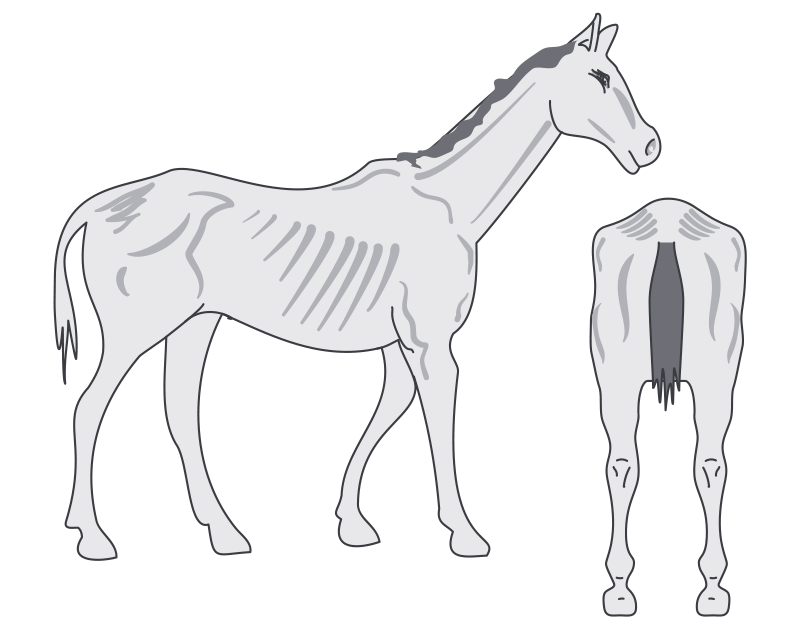 |
|
| 2 Moderate | 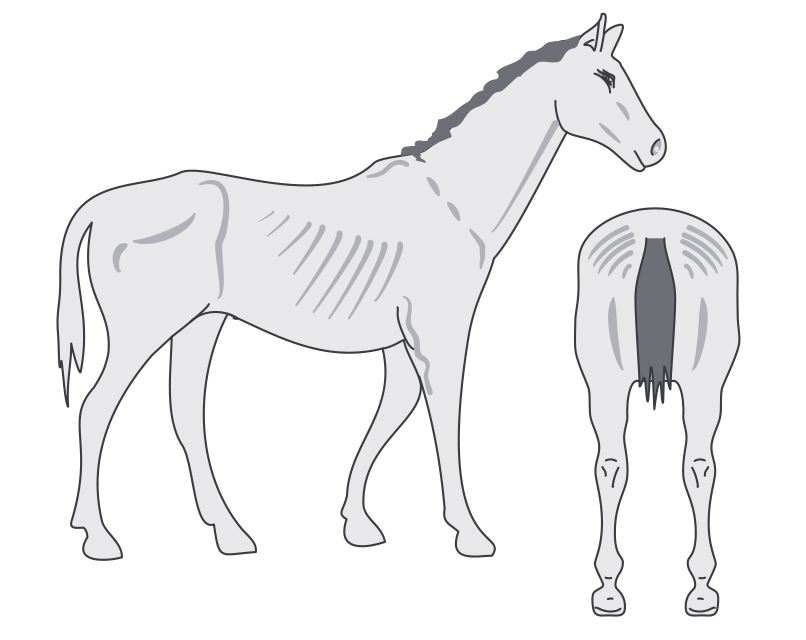 |
|
| 3 Good | 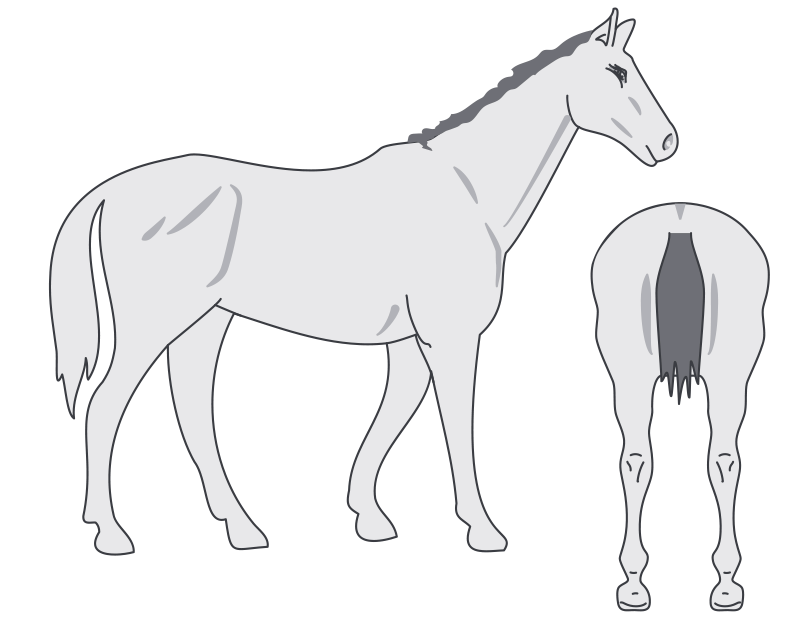 |
|
| 4 Fat | 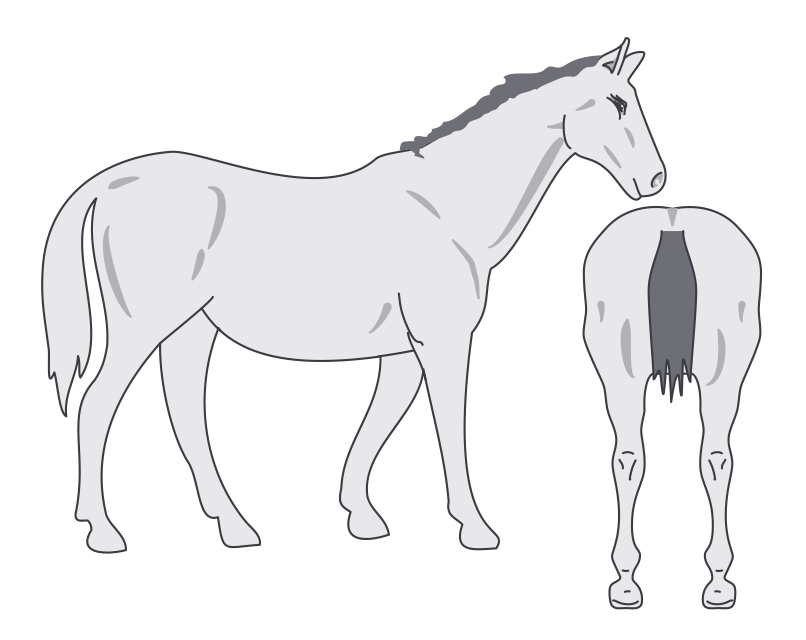 |
|
| 5 Very fat |  |
|
Fig. 1 Condition scores
The horse's weight can then be predicted from the height (in hands) and condition score (table 2). More accurate estimation can be achieved by the use of a nomogram (figure 4).
Table 2. Prediction of weight (kg) utilising height and condition score
| Condition score | Height (hands) | ||||
|---|---|---|---|---|---|
| 12H | 13H | 14H | 15H | 16H | |
| 1 | 190 | 240 | 310 | 390 | 420 |
| 2 | 210 | 285 | 330 | 420 | 470 |
| 3 | 250 | 345 | 395 | 460 | 505 |
| 4 | 300 | 370 | 460 | 535 | 570 |
| 5 | 360 | 460 | 540 | 610 | 670 |
1 hand = 10.2 cm (4 inches)
Allowing body condition to fall below a score of 2 is likely to compromise a horse's welfare.
During winter, a long heavy hair coat complicates visual appraisal. You need to run your hands over the horse to get an accurate score.
Poor body condition is not always due to lack of feed but could be related to parasite infestations, poor dental health, chronic injury or illness or lack of mobility affecting the horse's ability to forage.
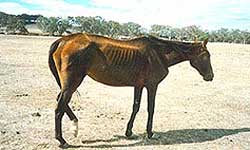

To estimate a horse's weight using condition score and height on a nomogram, a ruler is used to connect the appropriate values on the condition score and height scales, and the weight is read where it intersects the weight scale (Figure 4).
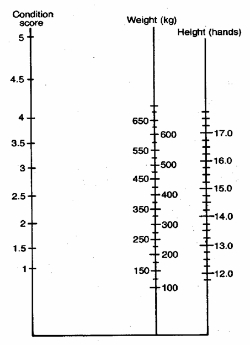
Alternatively a horse's estimated weight can be calculated from the girth and length (Figure 5), using a nomogram (Figure 6) or the below formula:
weight (kg) = girth (cm) x girth (cm) x length (cm) divided by 12000

To estimate a horse's weight using height and length measurements on a nomogram, a ruler is used to connect the appropriate values on the girth and length scales, and the weight is read where it intersects the weight scale.

Reference
Carroll,C.L. and Huntington, P.J. (1988) Body condition scoring and weight estimation of horses, Equine Veterinary Journal 20, 41-45.
Further information
Further information on horse ownership and management call our Customer Service Centre on 136 186.